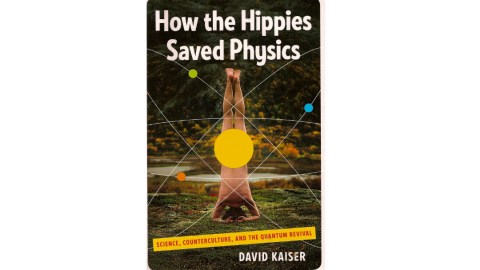Turn On, Tune In, Calculate. How the Hippies Saved Physics

There’s something happening and you don’t know what it is: PhD physicists from elite programs dabbling in the occult. These physicists, described in David Kaiser’s new book How the Hippies Saved Physics, would seem to fit right in with the other zany characters who inhabit Bob Dylan’s song, “Ballad of a Thin Man.”
And yet unlike Dylan’s Mr. Jones, whose world makes less and less sense to him the more he asks questions, the members of a Berkeley physics discussion group asked what Kaiser calls “the late night big questions of quantum theory” which served to refocus the field of quantum physics.
This all happened at a critical point in history, which Kaiser, History of Science professor at MIT, brings to life in his captivating narrative. Kaiser describes a post-war America with a “standing army” of physicists “trained and ready should the Cold War ever turn hot.”
Since manpower was “tethered to the demands of national security,” narrow skills that tended toward the “technical mathematical aspects” of physics were stressed in instruction. The actual meaning of quantum physics, on the other hand, was regarded as a philosophical tangent. Kaiser says this “aggressively pragmatic” approach to physics was an unfortunate “intellectual trade-off,” as postwar physics students were being trained as calculating automatons who weren’t able to “daydream about philosophical chestnuts.” He writes:
Before the war, Einstein, Bohr, Heisenberg, and Schroedinger had held one model in mind for the aspring physicist. A physicist should aim, above all, to be a Kulturtraeger–a bearer of culture–as comfortable reciting passages of Goethe’s Faust from memory or admiring a Mozart sonata as jousting over the strange world of the quantum.
And yet, in postwar America, philosophical engagement with quantum theory had fallen out of fashion and “the fundamental strangeness of quantum reality had been leeched out.”
Enter the hippies, who started asking questions, and making physics fun again.
The “Fundamental Fysiks Group” was a ragtag assortment of PhDs whose “playful provocations led to lasting contributions,” Kaiser tells Big Think. So how did this group come to be, and what can we learn from them?
These physicists saw their promising career paths disrupted when Congress and military analysts dramatically scaled back physics funding during the Vietnam War. In 1971, the Placement Service of the American Institute of Physics registered 1,053 applicants for just 53 jobs. The market could no longer absorb all of these “exquisitely well-trained” physicists who had gone to school during the glory days of science in the U.S. They were the Sputnik generation, Kaiser reminds us, who “grew up with a gleam in their eye.” And then their fortunes changed dramatically. And therein lies the essential lesson of Kaiser’s book.
According to Kaiser, the members of the Fundamental Fysiks Group displayed extraordinary passion, curiosity and playfulness “even during very difficult circumstances.” Forced to the margins, these physicists constructed their own jury-rigged “parellel universe” of millionaire patrons “with a hankering for quantum weirdness” and other “enthusiastic eccentric individuals.” They had “all kinds of conversations with all kinds of people” and were “open to questions that were asked by interested amateurs,” Kaiser says. In other words, they were entrepreneurs who found new ways to secure funding, and experimented with “new ways to do physics.”
These physicists also wrote bestselling books and brought attention to previously neglected thought experiments, such as Bell’s theorem (that “a measurement of particle A would instantaneously affect particle B, even if they were a galaxy apart.”). This led to the birth of quantum information science.
These physicists also studied subjects such as mind-reading and quantum mysticism and thereby proved “there is a space for this at the table in mainstream physics,” Kaiser says.
So in what way did the hippies save physics? Kaiser admits there is some bravado in his title. And yet, how do the predominate questions and methods of any scientific field change? This question fascinates Kaiser, who writes of the “messy alchemy” of mixing institutions and ideas: “Brilliant insights and dazzling discoveries take their place alongside political decisions, funding battles, personal rivalries, and cultural cues.” The hippie physicists were caught up in all of these upheavals, which Kaiser says are the ingredients that made up a seismic shift in modern physics.
As for the hippie physicists’ specific contributions, Kaiser lists three of them:
Watch Kaiser speak about his book in this video, courtesy of the Institute for Quantum Computing at the University of Waterloo:
Check out How the Hippies Saved Physicshere.
Follow Daniel Honan on Twitter @Daniel Honan





